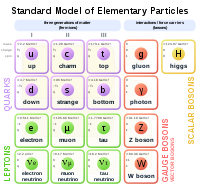
Weak interaction

In particle physics, the weak interaction, which is also often called the weak force or weak nuclear force, is the mechanism of interaction between subatomic particles that is responsible for the radioactive decay of atoms. The weak interaction serves an essential role in nuclear fission, and the theory regarding it in terms of both its behavior and effects is sometimes called quantum flavordynamics (QFD). However, the term QFD is rarely used because the weak force is better understood in terms of electroweak theory (EWT). In addition to this, QFD is related to quantum chromodynamics (QCD), which deals with the strong interaction, and quantum electrodynamics (QED), which deals with the electromagnetic force. The effective range of the weak force is limited to subatomic distances, and is less than the diameter of a proton. It is one of the four known force-related fundamental interactions of nature, alongside the strong interaction, electromagnetism, and gravitation. The Standard Model of particle physics provides a uniform framework for understanding the electromagnetic, weak, and strong interactions. An interaction occurs when two particles (typically but not necessarily half-integer spin fermions) exchange integer-spin, force-carrying bosons. The fermions involved in such exchanges can be either elementary (e.g. electrons or quarks) or composite (e.g. protons or neutrons), although at the deepest levels, all weak interactions ultimately are between elementary particles. In the case of the weak interaction, fermions can exchange three distinct types of force carriers known as the W+, W−, and Z bosons. The mass of each of these bosons is far greater than the mass of a proton or neutron, which is consistent with the short range of the weak force. The force is in fact termed weak because its field strength over a given distance is typically several orders of magnitude less than that of the strong nuclear force or electromagnetic force. Quarks, which make up composite particles like neutrons and protons, come in six 'flavors' – up, down, strange, charm, top and bottom – which give those composite particles their properties. The weak interaction is unique in that it allows for quarks to swap their flavor for another. The swapping of those properties is mediated by the force carrier bosons. For example, during beta minus decay, a down quark within a neutron is changed into an up quark, thus converting the neutron to a proton and resulting in the emission of an electron and an electron antineutrino. The weak interaction is the only fundamental interaction that breaks parity-symmetry, and similarly, the only one to break charge parity symmetry. Other important examples of phenomena involving the weak interaction include beta decay, and the fusion of hydrogen into helium that powers the Sun's thermonuclear process. Most fermions will decay by a weak interaction over time. Such decay makes radiocarbon dating possible, as carbon-14 decays through the weak interaction to nitrogen-14. It can also create radioluminescence, commonly used in tritium illumination, and in the related field of betavoltaics.
